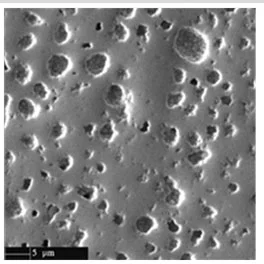Die Untersuchung von Kernbrennstoff bei sehr hohem Abbrand ist entscheidend für die Bewertung der Sicherheitsmargen des untersuchten Brennstoffs unter normalen sowie unter Unfallbedingungen. Das PSI ist eines der wenigen heißen Labore, die Zugang zu bestrahltem UO₂-Brennstoff mit sehr hohem Abbrand aus kommerziellen Reaktoren haben. Die Anwendung relevanter Werkzeuge zur Untersuchung, Handhabung und Analyse dieser hoch bestrahlten Materialien unterstreicht die erforderliche Expertise. Die abgeschirmten Instrumente des Labors wurden für detaillierte Analysen der Struktur und Zusammensetzung verschiedener Brennstoffpellets verwendet, die in kommerziellen Reaktoren mit Abbränden von über 70 MWd/kgSM bis zu 105 MWd/kgSM bestrahlt wurden.
Die Ergebnisse zeigen eine hohe Spaltgasfreisetzung von bis zu 42 %. Detaillierte Untersuchungen der radialen Verteilung von Xenon und der Verteilung des Spaltgases zwischen Blasen und der Brennstoffmatrix zeigen, dass die Freisetzung aus dem Brennstoff in mittleren radialen Positionen hauptsächlich für die hohe Spaltgasfreisetzung verantwortlich war. In dieser Untersuchung wurde festgestellt, dass selbst wenn nur ein Teil des aus der Brennstoffmatrix freigesetzten Gases in den Gasporen enthalten ist (der Rest wird in das freie Volumen des Brennstabs abgegeben), der Gasdruck in den Poren bis zu 70-mal höher ist als der Gleichgewichtsdruck.
Es kann daraus geschlossen werden, dass die Gasfreisetzung aus hoch abgebranntem Brennstoff während eines Unfalls erheblich zunimmt, wenn eine thermische Freisetzung in einem Bereich des Brennstoffs induziert wird, der die Hochabbrandstruktur enthält. Darüber hinaus muss die Spaltgasfreisetzung aus der Hochabbrandstruktur unterhalb der Temperaturschwelle für die thermische Freisetzung bei sehr hohen lokalen Abbränden berücksichtigt werden.
Original Publikation
*Journal of Nuclear Materials *
(R. Restani, M. Horvath, W. Goll, J. Bertsch, D. Gavillet, A. Hermann, M. Martin, C.T. Walker Journal of Nuclear Materials 481 (2016) 88-100)

